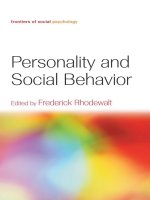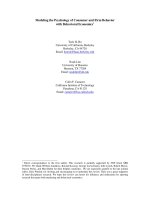CONSUMER MARKETS AND BUYER BEHAVIOR
Bạn đang xem bản rút gọn của tài liệu. Xem và tải ngay bản đầy đủ của tài liệu tại đây (668.27 KB, 27 trang )
6. CONSUMER MARKETS AND BUYER BEHAVIOR
Consumer Buyer Behavior —
The buying behavior of final consumers-
individuals and households who buy goods
and services for personal consumption.
COLLEGE OF BUSINESS ADMINISTRATION
CHUNG-ANG UNIVERSITY
PROF HYUNSUK SUH
2
What is “Consumer Buyer Behavior”?
Consumer Buyer Behavior
Consumer Buyer Behavior: The buying behavior of final consumers- individuals
and households who buy goods and services for personal consumption.
Kotler and Armstrong, 2013
Consumer Behavior: It is the process by which individuals or groups select, use,
or dispose of goods, services, ideas, or experiences to satisfy needs and wants.
Sheth and Krishnan, 2004
Consumer behavior is the study of individuals, groups, or organizations and the
processes they use to select, secure, use, and dispose of products, services,
experiences, or ideas to satisfy needs and the impacts that these processes have
on the consumer and society. Hawkins, Mothersbagh, and Best, 2007
3
The objectives of the current chapter are described.
Objectives
Understand the model of consumer buyer behavior
Understand the major factors that influence consumer buyer behavior
Understand the different stages of the buyer decision process
0. Objectives
4
To understand consumer behavior, we need to understand how consumers perceive,
learn, and make decisions to satisfy their needs and wants.
Model: Stimulus-Response of Buyer Behavior
How do consumers respond to various marketing efforts the company use?
Key
Question
Marketing and other stimuli
Marketing
Product
Price
Place
Promotion
Other
Economic
Technological
Political
Cultural
Buyer’s Black Box
Buyer
characteristics
Buyer Decision
Process
Buyer Responses
Product choice
Brand Choice
Dealer choice
Purchase timing
Purchase amount
Stimulus
Organism
Response
- Marketing and other stimuli enter the buyer’s “black box” and produce certain choice /
purchase responses.
- Marketers must figure out what is inside of the buyer’s “black box” and how stimuli are
changed to responses.
1. Factors Affecting Buyer Behavior
5
Factors Affecting Consumer Behavior
There are complex factors in the black box that influence buyer behavior that can be
categorized.
Cultural
Cultural
Culture
Subculture
Social class
Culture
Subculture
Social class
Social
Social
Reference groups
Family
Roles and status
Reference groups
Family
Roles and status
Personal
Personal
Age and lifecycle
Economic
situation
Occupation
Lifestyle
Personality
Age and lifecycle
Economic
situation
Occupation
Lifestyle
Personality
Psychological
Psychological
Motivational
Perceptual
Learning
Beliefs and
attitudes
Motivational
Perceptual
Learning
Beliefs and
attitudes
1. Factors Affecting Buyer Behavior
BUYER
6
Cultural Factors
Cultural factors exert the broadest and deepest influence on consumer behavior
The set of basic values, perceptions, wants, and behaviors learned by a member of
society from family and other important institutions
(e.g. Color red, funeral, Campbell’s soup)
Culture
A group of people with shared value systems based on common life experiences
and situations
(e.g. Religions, racial groups-Hispanics are branded, higher quality products)
Subculture
Relatively permanent and ordered divisions in a society whose members share
similar values, interests, and behaviors
(e.g. frame of reference, order of hierarchy, and order changes)
Social class
1. Factors Affecting Buyer Behavior
7
۵
Culture is the complex whole that includes knowledge, belief, art, law, morals,
customs, and any other capabilities and habits acquired by humans as members
of society. (Hawkins, Mothersbagh, and Best, 2007)
۵
Culture is the collective programming of the mind that distinguishes the
members of one category of people from those of another. (Geert Hofstede)
Let’s take a look at the definitions about culture.
Culture Definitions
1. Factors Affecting Buyer Behavior
Although pizza is eaten most everywhere, what is on the pizza can
be quite different!
Pepperoni
Squid
Tuna & Corn
Black Bean
Sauce
BBQ Chicken
Eggs
8
The diversity of cultures around world is also reflected in languages.
CULTURE WATCH: Using English as a Marketing Tool in Japan
In Japan, consumer packaged goods have English, French, or German labels to
suggest a stylish, Western look. A Westerner may wonder what the copywriters
wish to achieve. English on the label of City Original Coffee proclaims "Ease Your
Bosoms. This coffee has carefully selected high quality beans and roasted by our
all the experience." The intended message: Drinking the coffee provides a
relaxing break and "takes a load off your chest." One expert believes these
messages highlight differences between Japanese and other languages. Many
Western languages lack exact equivalents for the rich variety of Japanese words
that convey feelings. This presents difficulties for copywriters trying to render
feelings in a language other than Japanese.
Q: Why are Japanese retailers unconcerned that the messages are syntactically
suspect ?
Culture Watch: Using English as a Marketing Tool in Japan
1. Factors Affecting Buyer Behavior
Example
9
The important distinction between cultures suggested by Hall is that between HIGH
and LOW context cultures which are described below.
High and Low Context Cultures
HIGH CONTEXT
- Nonverbal messages are full of important and intended meanings
- When words are spoken, “reading between the lines” is important emphasis
on background, basic values
-The meaning of individual behavior and speech changes depending on the
situation or context
- Less emphasis on legal paper work
- Focus on personal reputation
- Latin American countries, Japan, and industrializing Asian countries
LOW CONTEXT
- Messages are explicit and specific
- Words carry all information (intentions are expressed verbally)
- Reliance on legal paperwork
- Focus on non-personal documentation of credibility
- Low context cultures can be found in culturally diverse countries such as
Switzerland, US, and Germany
1. Factors Affecting Buyer Behavior
10
The high and low context cultures across different countries are illustrated below.
High and Low Context Cultures
H/L Communication Style
A US business man picked up a German
client from his hotel near LAX and asked
what kind of food he wanted for dinner. He
said, “something local.” Now in LA, the
local food is Mexican food. We went to a
great Mexican restaurant in Santa Monica
and had it all. When we were done I asked
him how he like the food. He responded
rather blandly, “It wasn’t very good”.
Germans being low-context oriented, they
deliver information without any social
padding. If it was Americans in the same
situation, the answer would more likely be
“It was pretty good but a bit too spicy.” A
Japanese would answer “It was very good.
Thanks.” But he would never order Mexican
food again.
1. Factors Affecting Buyer Behavior
Example
11
Social Factors
Social factors influence on consumer behavior in terms of reference groups, family,
and social roles and responsibilities.
Two or more people who interact to accomplish individual or mutual goals.
(e.g. Membership group, aspirational group, dissociative group, category group)
Reference
Group
Family members can strongly influence buyer behavior
Family
The reference group influences consumers via following factors
1. Information influence (expert opinions, opinion leaders, experience of colleagues)
2. Comparative influence (individuals follow group pattern)
3. Normative influence (individuals follow group norm)
Examples
1. Collaborative decision making (buying a house, vacation, children education)
2. Self-administration (cigarette, liquor, cosmetics)
3. Wife-controlled (house ware, detergent, food)
4. Husband-controlled (automobile)
Examples
1. Factors Affecting Buyer Behavior
12
Personal Factors
Personal factors also influence on consumer behavior in terms of age and life cycle
stage, occupation, economic situation, lifestyle, and personality & self-concept.
Consumer’s buying behavior is shaped by the stage of life cycle.
(e.g. Nontraditional stages such as unmarried couple, marrying later in life, childless
couple, single parent)
Age and
Life cycle
A person’s occupation affects the goods and services bought.
A person’s economic situation will affect product choice
Occupation
and
Economic
situation
A person’s pattern of living as expressed in his or her activities, interests, and
opinions. It involves measuring consumer’s AIO dimensions: Activities (hobby,
shopping, sports), Interests (food, fashion, recreation), Opinions (issues, biz, product)
Lifestyle
A person’s distinct personality influences his or her buying behavior.
(e.g. self-confidence, dominance, sociability, autonomy, adaptability)
Personality
and
Self-concept
1. Factors Affecting Buyer Behavior
13
Fulfilleds
Believers
Achievers
Strivers
Experien-
cers
Makers
Principle Oriented
Status Oriented
Action Oriented
Low Resources
High Resources
High Innovation
Low Innovation
Strugglers
Actualizers
VALS Lifestyle Classifications
Ref: SRI international
The most widely used lifestyle classifications, research firms developed is VALS
(Values and Lifestyles developed by SRI consulting).
segmenting the consumer marketplace on the basis of the personality traits that drive consumer
behavior
1. Factors Affecting Buyer Behavior
14
Category
Description
Actualizers
(Innovators)
Fulfilleds
(Thinkers)
Achievers
Experiencers
They are successful, sophisticated, take-charge people with self-esteem. Image is
important as expression of their taste and independence. They are the leaders and seek
challenge.
The are motivated by ideals. They are well-educated and seek out information in
decision-making process. They are conservative, practical consumers: they look for
durability, functionality, and value in products they buy.
They have goal-oriented lifestyles and a deep commitment to career and family. They
are politically conservative and respect authority. They prefer prestige products to
demonstrate success to their peers. They like variety of time-saving devices.
They are motivated by self-expression. As young, enthusiastic and impulsive
consumers, their energy finds an outlet in exercise, sports, outdoor recreation, and
social activities. They spend comparatively high portion of income on fashion,
entertainment, and socializing.
Characteristics of VAL Category
The VALS categories are described below. (1/2)
1. Factors Affecting Buyer Behavior
15
Category
Description
Believers
Strivers
Makers
Strugglers
(Survivors)
They are conservative people with concrete beliefs on family, religion, and nation. They
express deep moral codes. As consumers, they are predictable: they choose familiar
products and established brands. They are loyal to their national products.
The are trendy and fun-loving. They are concerned about the opinions and approvals of
others. Money defines success for them. They emulate the purchases of people with
greater material wealth. They are active consumers because shopping is both social
activity and an opportunity to demonstrate to peers their ability to buy.
Like experiencers, they are motivated by self-expression by working on building a
house, raising children, fixing a car, or growing vegetables. They are suspicious to new
ideas and unimpressed by material possession. They buy basic products (prefer value to
luxury)
They live narrowly focus lives. Due to shortage of resources, they must focus on
meeting needs rather than fulfilling desires. They are cautious with loyal to favorite
brands as long as they can purchase them at a discount stores.
Characteristics of VAL Category
The VALS categories are described below. (2/2)
1. Factors Affecting Buyer Behavior
16
VALS Questionnaire
Results
Ref: />The example of VALS survey is described below.
1. Factors Affecting Buyer Behavior
Homework
a. What is your VALS type? Do
you agree with the assessment?
b. How can marketers use VALS
information to serve consumers
better?
Example
17
Psychological Factors
Psychological factors also influence on consumer behavior in terms of motivation,
perception, learning, and beliefs & attitudes.
A need that is sufficiently pressing to direct the person to seek satisfaction
(e.g. Maslow’s needs hierarchy)
Motivation
The process by which people select, organize, and interpret information to form a
meaningful picture of the world
(e.g. selective attention, selective distortion, selective retention)
Perception
Changes of an individual’s behavior arising from experience
(e.g. conceptual learning, experienced learning)
Learning
1. A descriptive thought that a person holds about something
2. A person’s consistently favorable/unfavorable evaluations, feelings, and tendency
toward an object or idea
Beliefs
and
Attitudes
1. Factors Affecting Buyer Behavior
18
Maslow’s Hierarchy of Needs
■
A person tries to satisfy the most
important need first.
■
When the need is satisfied, it will
stop being a “motivator” and a
person will try to satisfy the next
most important need.
■
Without most pressing needs
being satisfied, the next phase
won’t be satisfied.
■
(e.g. starving people will not take
interest how they are seen or
esteemed by others (esteem
needs), or what’s happening in the
art world (self-actualization))
Maslow’s hierarchy of needs explain why people are driven by particular needs by
particular times.
1. Factors Affecting Buyer Behavior
19
The tendency of people to screen out most of the information to which they are
exposed
Selective
Attention
The tendency of people to interpret information in a way that will support what
they already believe
Selective
Distortion
The tendency to retain information that supports their attitudes and beliefs
Selective
Retention
Types of Perceptual Information Processing
Amongst exposed stimuli, people form different perceptions of the same stimulus due
to three perceptual processes.
1. Factors Affecting Buyer Behavior
20
Buyer Decision Process
The buyer decision process is illustrated below.
Need
Recognition
Information
Search
Evaluation of
Alternatives
Purchase
Decision
Post-purchase
Behavior
The first stage of
buyer decision
process in which
consumer recog-
nizes a problem or
needs
The consumer is
aroused to search
for more
information
The consumer uses
information to
evaluate alternative
brands in the
choice set
The buyer’s
decision about
which brand to
purchase
The consumers
take further action
after purchase,
based on their
satisfaction or dis-
satisfaction
2. Decision Process
21
Need
Recognition
Types of Need
The precise understanding of consumer’s need is the very first step to understand
consumer behavior.
1. Utilitarian Need
Satisfying practical need of the consumer
-Focused on thinking and cognition of
practicality
(e.g. house ware, machinery)
2. Self-expressive Need
-Focused on individual characteristic
(e.g. suit, cosmetics, accesory, perfume)
3. Hedonic Need
-Focused on feeling and affection
(e.g. music, travel)
To arouse
purchase
urge
Current state
Ideal state
GAP!!!
2. Decision Process
22
Information
Search
Types of Information Source
The consumer’s evaluation of the product or service starts from information search.
Information Source
1. Internal Source (consumer’s memory)
2. External Source
Personal Non-personal
Marketer Sales person
Exhibit
(showroom)
Advertisement
Promotion
Outer-marketer WOM
Expert opinion
Newspaper
Magazine
Attention: Yerkes-Dodson’s Law
Info-
processing
Ability
High
Low
High
Attention focus
Arousal level
Proper
Loose
Attention
Narrow
Attention
- Attention and Arousal are closely related to
each other
-
If arousal is too low, attention is loose, and
your ability to process info is also low
- If arousal is too high, attention is too
focused and becomes narrow, so that you are
not able to process information correctly
Useful
Theory
2. Decision Process
23
Information
Search
Perception: Information Distortion
Perception: Information Organization
Information selection can be perceived in distored
manner
1. Perceptual defense ( 방어 )
People tend not to perceive certain object or
information that are opposite to his/her belief
(e.g. advertisement, cigarette smoker tend to
avoid smoking-free campaign)
2. Perceptual vigilance ( 경각 )
On typical situation, people tend to perceive
certain object or information better than normal
situation
(e.g. Starved group tend to perceive food-related
words relatively faster than other words)
Characteristic of Information organization
process can be twofold
1. Categorization ( 항목화 )
People tend to organize information of new
products based on their prior knowledge
(e.g. resale vale of Hyundai Accent vs.
Benz)
2. Integration ( 통합화 )
People tend to perceive information as
“organized whole” rather than “individuali-
zed”
(e.g. Halo effect)
Some of the information perception theories are described below.
2. Decision Process
24
Evaluation of
Alternatives
Types of Evaluation
When consumers evaluate product and service, they use both internal sources of
information (memory) as well as external sources.
1. Stimulus-based
(e.g. purchasing unknown/unused products)
2. Memory-based
(e.g. selecting experienced goods and services)
3. Out of sight, out of mind
(except, comparatively more number of
superior attributes, exaggeration)
Useful
Theory
Category vs. Attribute
1. Categorization ( 항목 )
e.g. Bird-eagle, canary, parrot
2. Attribute ( 속성 )
Intrinsic: color, size, styles
Extrinsic: brand, country of origin,
price
Example:
500 candidates have applied to A
company where it only plans to hire 20
new employees.
Methods
1. Read all the details of the documents
each candidates handed in. Interview
every individuals to make evaluation.
2. Make an assessment based on the
important list of items such as the level of
education, job experience, and etc.
2. Decision Process
25
When consumers making decisions about the purchase, they make the complicated
problems simple and make decisions on their own called “decision fallacy”.
Types of Decision fallacy
Purchase
Decision
1. 축소처리 오류 (UNDERPROCESSING BIAS)
(e.g. McDonald, WOM-friend’s opinion)
2. 확대처리오류 (OVERPROCESSING BIAS)
(e.g. 원산지 명 , 브랜드 명 , dilution effect )
3. 상황적 오류 (SITUATIONAL BIAS)
(e.g. 23C in March Vs. 23C in August; 3 월 달의
23 도의 온도와 8 월 달의 23 도의 온도 )
Types of Decision Behavior
Complex
buying
behavior
Variety-
seeking
buying
behavior
Dissonance-
reducing
buying
behavior
Habitual
buying
behavior
High Involvement
Low Involvement
Significant diff.
b/w Brands
Few diff.
b/w Brands
2. Decision Process









